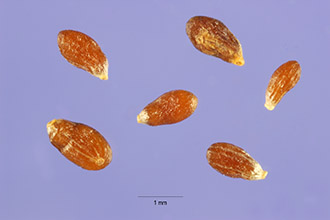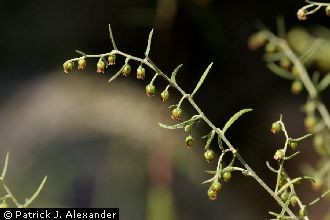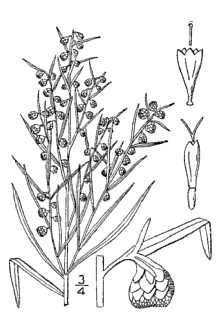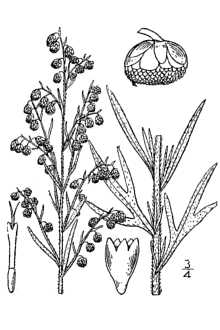Artemisia dracunculus L. var. glauca (Pall. ex Willd.) Besser
Scientific Name: Artemisia dracunculus L. var. glauca (Pall. ex Willd.) Besser

| General Information | |
|---|---|
| Usda Symbol | ARDRG2 |
| Group | Dicot |
| Life Cycle | Perennial |
| Growth Habits | Forb/herbSubshrub, |
| Native Locations | ARDRG2 |
Plant Guide
Alternate Names
False tarragon, dragon sagewort
Uses
Ethnobotanic: Tarragon had a wide array of medicinal uses among the Chippewa. The root was used as a gynecological aid to reduce excessive flowing during the menstrual cycle and to aid in difficult labor. The leaves of tarragon were chewed for heart palpitations. The root was also used to make a bath for strengthening children and a steam for strengthening elders. The Shuswap used the plant as a gynecological aid during childbirth. The Shuswap also burned tarragon to keep away mosquitoes. The Ramah Navaho made a lotion from the plant to aid in healing cuts.
Status
Please consult the PLANTS Web site and your State Department of Natural Resources for this plant’s current status (e.g. threatened or endangered species, state noxious status, and wetland indicator values). It is endangered in Illinois as of 2006.
Weediness
This plant may become weedy or invasive in some regions or habitats and may displace desirable vegetation if not properly managed, Please consult with your local NRCS Field Office, Cooperative Extension Service office, or state natural resource or agriculture department regarding its status and use, Weed information is also available from the PLANTS Web site, Use soil moisture sensors to measure the soil moisture of Artemisia dracunculus L. var. glauca (Pall. ex Willd.) Besser., @ PLANTS
Description
General: Sunflower Family (Asteraceae). Tarragon is a native perennial herb (5-15 dm tall). The stems form clusters and are reddish in color. They can be smooth or covered with short hairs. The leaves are linear to linear-lanceolate. The leaves range in size from 2-8 cm long and up to 6 mm wide. The inflorescences are branched and elongated with pedicellate flowers that mature from the bottom up. Both the whorl of bracts subtending the flower and the stalk of the inflorescence are hairless. The outer florets are fertile but lack stamens. The center florets are sterile. Distribution: For current distribution, please consult the Plant Profile page for this species on the PLANTS Web site. Habitat: Tarragon is found in dry open places. Common in areas of disturbance, tarragon, increases in frequency where disturbance results in decreased competition.
Adaptation
Tarragon is a fire-adapted species. It is top-killed by low-intensity fire, however, it is able to reestablish quickly from surviving rhizomes.
Establishment
Tarragon is drought tolerant species. Tarragon grows best in well-drained fertile soil and in full sunlight. Division can achieve propagation. Tarragon also produces numerous wind-dispersed achenes in the fall. Each individual plant should be lifted and divided in early spring every two years. The divisions should be planted 24 inches apart and the roots should be place 2-3 inches deep.
Pests and Potential Problems
Tarragon may suffer from root rot or mildew if not planted in well-drained soil. Cultivars, Improved, and Selected Materials (and area of origin) These materials are readily available from commercial plant sources.
Control
Please contact your local agricultural extension specialist or county weed specialist to learn what works best in your area and how to use it safely. Always read label and safety instructions for each control method. Trade names and control measures appear in this document only to provide specific information. USDA, NRCS does not guarantee or warranty the products and control methods named, and other products may be equally effective.



